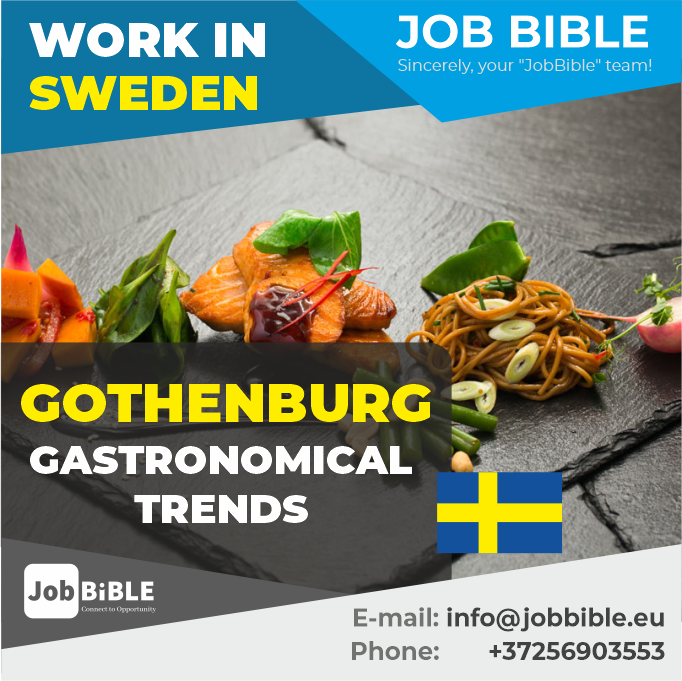Gothenburg is considered the second city in Sweden after Stockholm. The second in everything: in terms of the number of people, the number of museums and galleries, the rent for an apartment. Only in one point Gothenburg is certainly ahead of Stockholm: in terms of the quality of food, especially seafood, it is undoubtedly the first. It is in Gothenburg that the best fish in Sweden is served. It is here that the best fish restaurants are located, five of which are marked with a Michelin star.
Gothenburg is located on the North Sea, colder and saltier than the Baltic Sea. The location of the city is a great success for fishermen and gourmets. You can go to Gothenburg for fish at any time of the year. Local fishermen in any season go to sea every night and return to the city for the morning fish auction. In the process of fishing, by the way, tourists can also take part. True, not in Gothenburg itself, but in neighboring fishing villages – for example, Kledesholmene (about an hour by land or 30 minutes by sea from the city).
During the “lobster safari” arranged especially for tourists, you can “hunt” for seafood yourself. “Prey”, of course, is immediately eaten. You can try the freshly caught fish and seafood without leaving the city. Fishermen bring their night catch for sale every day. Large batches go to a fish auction, where an ordinary person cannot get: seafood is sold here in restaurants and fish shops. Housewives (or housewives – both options are relevant in Sweden) buy fish in the so-called “fish church”. This is how the locals call the fish market: a church-like building made of massive stone with a gable roof. The “Fish Church” is literally a cult site in Gothenburg. Locals even hold weddings here.
You can eat at the fish market not only if you are a guest at a wedding. On the inner balcony of the market there is a small restaurant where you can taste traditional dishes such as fish soup and fried fish, fresh seafood and oysters. The restaurant’s menu includes all the fish that is in the assortment of the market. By the way, the owner of the restaurant – the 2010 world champion in opening oysters Johan Malm, can even hold a master class for visitors on how to properly (and quickly) open an oyster. The “fish church” sells the best oysters in Sweden.
Oysters in Sweden are not artificially bred, as in France. Local large and quite fleshy oysters grow themselves, about 5-7 years, and only then they are caught by fishermen. According to the locals, the water and free life are unusually salty and clean and give Swedish oysters their special fresh taste. Indeed, oysters have a distinct taste of the cool sea air of the North Sea. Oysters here are usually served with slices of lemon and champagne or porter. However, the owner of the restaurant advises eating oysters as they are. According to him, the pure taste is better.
According to local chefs, fresh fish does not need a lot of tricks. If possible, nothing should be done about it at all. The ideal option for Swedish cuisine is a signature plate of seafood dish of the Michelin restaurant Fiskekrogen: slightly salted salmon, shrimp boiled in seawater, boiled lobsters and langoustines, mussels and the obligatory fresh oysters. Each type of seafood traditionally has its own sauce: to salmon – Dijon mustard with honey (an amazingly tasty combination), to shrimp – several types of mayonnaise or cocktail sauce.
Swedish chefs put emphasis on the freshness of the product and on the quality of food. According to Ulf Wagner, chef of the Michelin-starred restaurant Sjomagasinet in Gothenburg, Swedish cuisine fifty years ago was one of the most underrated in Europe. Too simple and poor – it was losing in comparison with the French, Italian and even German. Today, the situation has radically changed: now Swedish cuisine is considered one of the best in the world. For example, over the past ten years, seven Swedish chefs have received the title of world “chef of the year”.
This is not surprising. Swedish cuisine meets all the most modern gastronomic trends: it is fresh, healthy and beautifully served.
In addition, not the last role in the success of Swedish cuisine is played by the very attitude of the Swedes to food. For example, Ulf Wagner, the owner of two large restaurants, a professor at the University of Gothenburg, the organizer of many international culinary events, personally roasts fish for the buffet of his restaurant at lunchtime. He can’t do it any other way, because Swedish is synonymous with good, which means that you only need to do Swedish cuisine well.

